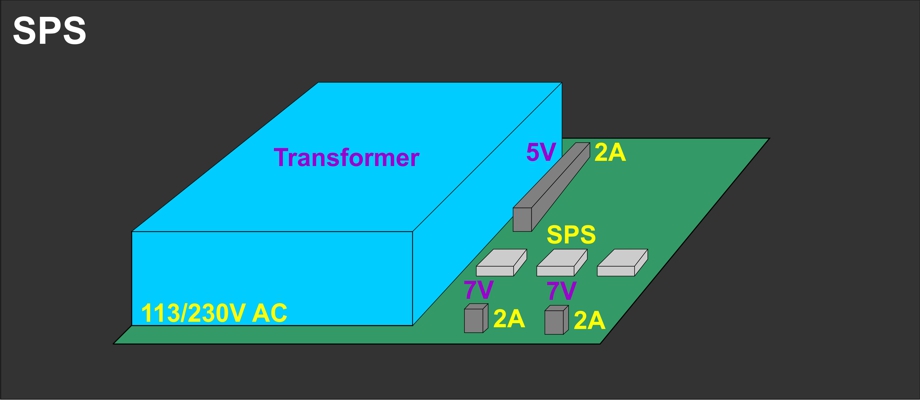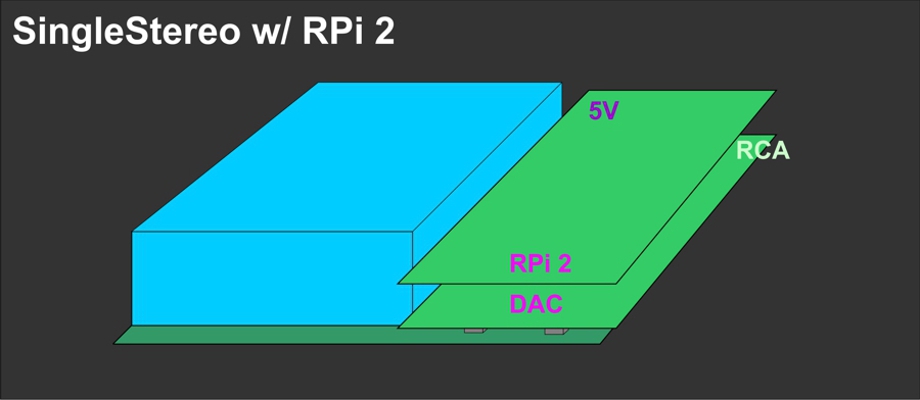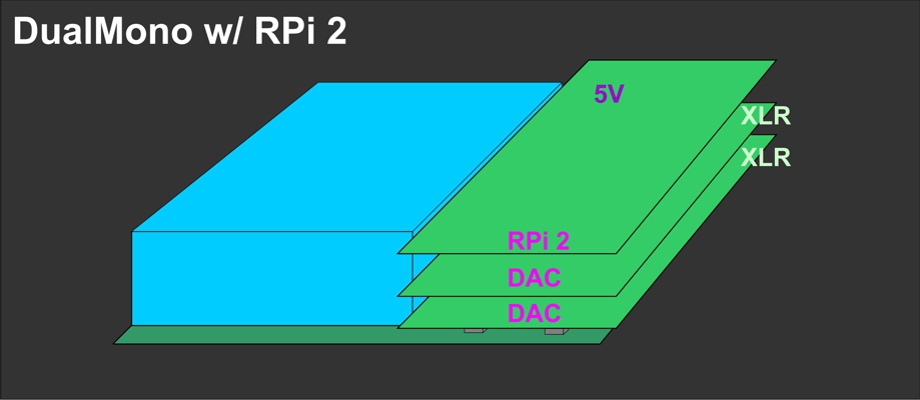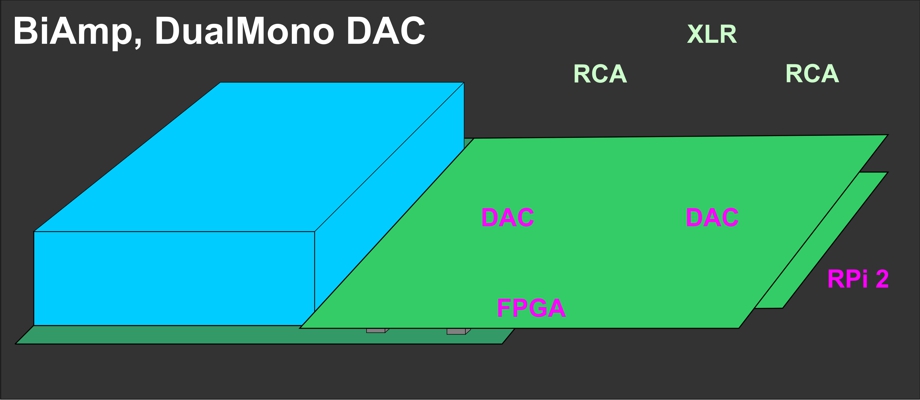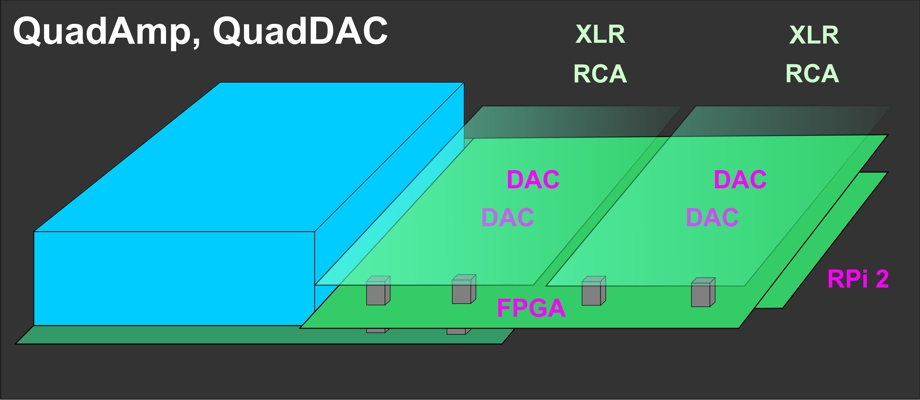Lyrebird Pi2DAC System
The Lyrebird Pi2DAC is based on the great sounding TI PCM1794A. The power comes via low voltage AC rectification and LDOs so that you could
connect directly a simple AC transformer (110/230V primary, 6..9V secondary, 50VA). The rectified DC is regulated by very low noise and very high ripple rejection
LDOs (1A).
The I/V and low pass filter stage are based on OpAmps. A wide range can be used: LME49990, OPA827 or OPA211 are suggested parts (depends on your listening preference:
LME49990 is very accurate and neutral, lowest noise and distortion; OPA827 sounds more like a tube amp; OPA211 is the compromise between both)
The DAC runs with 6V as well as the OpAmps (dual rail, -6V via fully separated AC coil). The output is amplified by the great TPA6120A headphone (HP) amplifier which can also drive low impedance loads such as small desktop speakers. The decision to run all with 6V is based on fact that the distortion on low frequency, bass, is smaller, less heat dissipation and easier to select an AC transformer.
The DAC board is a fully balanced design. The Single Stereo version converts into Headphone Out which can be used also as RCA to feed a power amp. The DualMono versions generate also a Fully Balanced Output, as 3.5mm to XLR connector passive breakout. RCA and Headphone out is still possible.
DualMono
Two similar DAC boards are used, just slightly differently jumpered. Each DAC board processes just one channel and privided fully balanced XLR output. It gives you
additional +3DB better SNR, better channel separation and EMI/noise injection umminity. RCA, Headphone or desktop speaker out is still possible (with a breakout
adapter or cable).
Dual FPGA NOS
Here, again two DAC boards, but in addition a third FPGA board. This FPGA board will audio procession, based on the I2S signal. It splits I2S into two separate
I2S streams which are upsampled (convert 48 KHz to 96 KHz, for instance), increase bit resolution (dithering) and use the feature on PCM1794A to run it with
external filter, as NOS DAC.
The FPGA supports also a Rotary Encoder which could be used as volume control, as navigation control for a graphical display. The Raspberry Pi can access the FPGA,
rotary encoder via a SPI interface.
BiAmp
BiAmping is a system to split the audio channel into low+mid and a separate tweeter channel, to use two DACs and power amps. It avoids large passive filters in loudspeaker.
The FPGA is used to split the frequencies, to have a programable cross-over filter. And it avoids to have a phase shift or attenuation done by any passive filter.
Or run the DualDAC instead in DualMono or NOS mode. Or have a DualRoom DAC with latency compensation and audio beam forming.
QuadDAC
Extend the BiAmp, DualDAC by additional DAC modules: add two for a BiAmp DualMono, NOS or add even six additional DAC modules. The
SingleStereo DAC module fits perfect and the BiAmp DAC can be extended any time. As OctalDAC you will get out almost all 24bit, with increased SNR.
Or: instead of BiAmping, do QuadAmp: split into four frequency ranges, with four amplifiers and feeding directly four loudspeakers, without any
phase distortion or power loss in speaker boxes.
Jitter Removal
I am thinking to use a silicon to do the upsampling. There are some, e.g. CS8421, SRC4392, which allow easy sample rate conversion, jitter reduction. And
as a great beauty: several TOSLINK, SPDIF Inputs and Outputs, including AES/EBU. Would be a great extension, to use Lirebird Pi2DAC as sound card, or
to send audio from Raspberry Pi 2 via TOSLINK, SPDIF to another sound card.
I will try to find time to design and evaluate a board with such a sample rate and interface converter (as option to FPGA).
SPS
The Power Supply Unit is optional and based on Switched Power Supply (SPS) circuits. It makes it easier to use a simple AC transformer, to avoid any hum (AC ripples)
and to deal with heat disspitation. It can also power the Raspberry Pi 2.
All fits in a way so that you can assemble a comples Lyrebird Pi2DAC without any wire and to have still access to GPIOs on Raspberry Pi.
VU Meter
The FGPA is not just used for Jitter Removal, audio filtering, e.g. Wide Stereo Effect
and to deal with heat disspitation. It can also power the Raspberry Pi 2.
A ring of 16 LEDs, as single-wire LEDs, displays the I2S signal volume peaks, 8 per channel, similar to an old style "Magic Eye".
